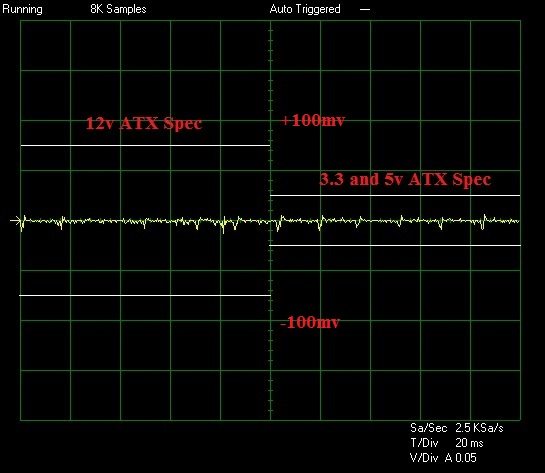Deepcool DQ1000 Quanta Power Supply Review
Ryan Martin / 10 years ago
Ripple
Noise and Ripple can easily be measured by an oscilloscope. These show how much voltage fluctuation there is on a particular rail. We tested the rail stability of the 3.3 volt, 5 volt and 12 volt rails using an identical time and millivolt scale for all graphs. millivolt ripple is measured by the peak to peak size of the voltage curve.

Sample Ripple Graph
The latest ATX 12 volt version 2.3 specifications state that ripple from peak to peak must be no higher than 50 millivolts for the 3.3 volt and 5 volt rails, while the 12 volt rail is allowed up to 120 millivolts peak to peak to stay within specifications. Millivolt figures are stated to the closest increment of 5 given their variability.
| Load (%) | 3.3V Ripple | 5V Ripple | 12V Ripple |
| 20 | 6.2 | 11.8 | 15.4 |
| 40 | 14.8 | 21.2 | 25.6 |
| 60 | 19.2 | 29.6 | 34.6 |
| 80 | 24.2 | 42.8 | 63.4 |
| 100 | 30.4 | 48.4 | 68.1 |
Oh dear….it was all going so well. This unit has already aced everything we’ve thrown at it but ripple was just one step too far. 3.3 volt ripple is too high and 5 volt ripple is bordering on ATX specifications: if you were to CrossLoad the 3.3 and 5 volt rail I have a feeling that the 5 volt rail would fail. The 12 volt rail wasn’t much better either: nearly 70mV of ripple for a high end unit is just plain weak. Better luck next time Deepcool.
3.3 volt @ 100%

5 volt @ 100%

12 volt @ 100%




















